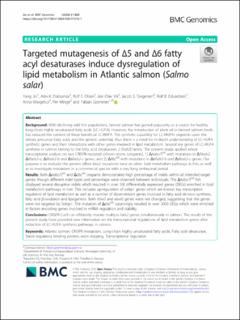| dc.contributor.author | Jin, Yang | |
| dc.contributor.author | Datsomor, Alex Kojo | |
| dc.contributor.author | Olsen, Rolf Erik | |
| dc.contributor.author | Vik, Jon Olav | |
| dc.contributor.author | Torgersen, Jacob Seilø | |
| dc.contributor.author | Edvardsen, Rolf Brudvik | |
| dc.contributor.author | Wargelius, Anna | |
| dc.contributor.author | Winge, Per | |
| dc.contributor.author | Grammes, Fabian | |
| dc.date.accessioned | 2021-01-25T09:10:34Z | |
| dc.date.available | 2021-01-25T09:10:34Z | |
| dc.date.created | 2020-11-20T03:19:38Z | |
| dc.date.issued | 2020 | |
| dc.identifier.citation | BMC Genomics. 2020, 21 (805), . | en_US |
| dc.identifier.issn | 1471-2164 | |
| dc.identifier.uri | https://hdl.handle.net/11250/2724445 | |
| dc.description.abstract | Background
With declining wild fish populations, farmed salmon has gained popularity as a source for healthy long-chain highly unsaturated fatty acids (LC-HUFA). However, the introduction of plant oil in farmed salmon feeds has reduced the content of these beneficial LC-HUFA. The synthetic capability for LC-HUFAs depends upon the dietary precursor fatty acids and the genetic potential, thus there is a need for in-depth understanding of LC-HUFA synthetic genes and their interactions with other genes involved in lipid metabolism. Several key genes of LC-HUFA synthesis in salmon belong to the fatty acid desaturases 2 (fads2) family. The present study applied whole transcriptome analysis on two CRISPR-mutated salmon strains (crispants), 1) Δ6abc/5Mt with mutations in Δ5fads2, Δ6fads2-a, Δ6fads2-b and Δ6fads2-c genes, and 2) Δ6bcMt with mutations in Δ6fads2-b and Δ6fads2-c genes. Our purpose is to evaluate the genetic effect fads2 mutations have on other lipid metabolism pathways in fish, as well as to investigate mosaicism in a commercial species with a very long embryonal period.
Results
Both Δ6abc/5Mt and Δ6bcMt crispants demonstrated high percentage of indels within all intended target genes, though different indel types and percentage were observed between individuals. The Δ6abc/5Mt fish displayed several disruptive indels which resulted in over 100 differentially expressed genes (DEGs) enriched in lipid metabolism pathways in liver. This includes up-regulation of srebp1 genes which are known key transcription regulators of lipid metabolism as well as a number of down-stream genes involved in fatty acid de-novo synthesis, fatty acid β-oxidation and lipogenesis. Both elovl5 and elovl2 genes were not changed, suggesting that the genes were not targeted by Srebp1. The mutation of Δ6bcMt surprisingly resulted in over 3000 DEGs which were enriched in factors encoding genes involved in mRNA regulation and stability.
Conclusions
CRISPR-Cas9 can efficiently mutate multiple fads2 genes simultaneously in salmon. The results of the present study have provided new information on the transcriptional regulations of lipid metabolism genes after reduction of LC-HUFA synthesis pathways in salmon. | en_US |
| dc.language.iso | eng | en_US |
| dc.publisher | BMC | en_US |
| dc.rights | Navngivelse 4.0 Internasjonal | * |
| dc.rights.uri | http://creativecommons.org/licenses/by/4.0/deed.no | * |
| dc.title | Targeted mutagenesis of Δ5 and Δ6 fatty acyl desaturases induce dysregulation of lipid metabolism in Atlantic salmon (Salmo salar) | en_US |
| dc.type | Peer reviewed | en_US |
| dc.type | Journal article | en_US |
| dc.description.version | publishedVersion | en_US |
| dc.source.pagenumber | 14 | en_US |
| dc.source.volume | 21 | en_US |
| dc.source.journal | BMC Genomics | en_US |
| dc.source.issue | 805 | en_US |
| dc.identifier.doi | 10.1186/s12864-020-07218-1 | |
| dc.identifier.cristin | 1850148 | |
| dc.description.localcode | © The Author(s). 2020 Open Access This article is licensed under a Creative Commons Attribution 4.0 International License | en_US |
| cristin.ispublished | true | |
| cristin.fulltext | original | |
| cristin.qualitycode | 1 | |

